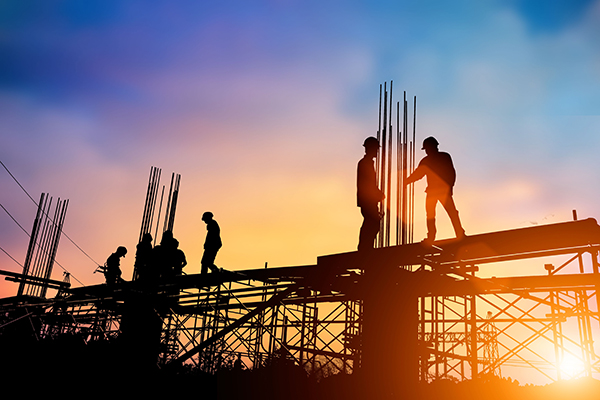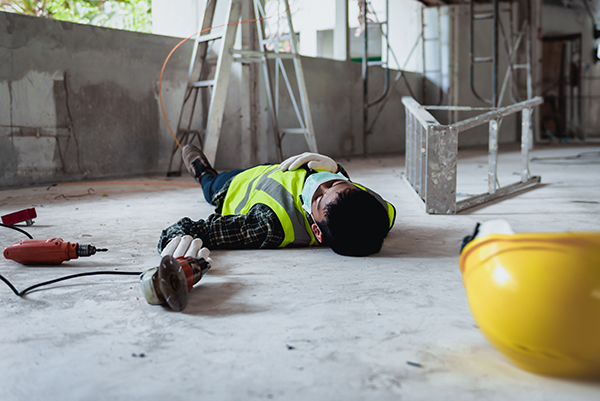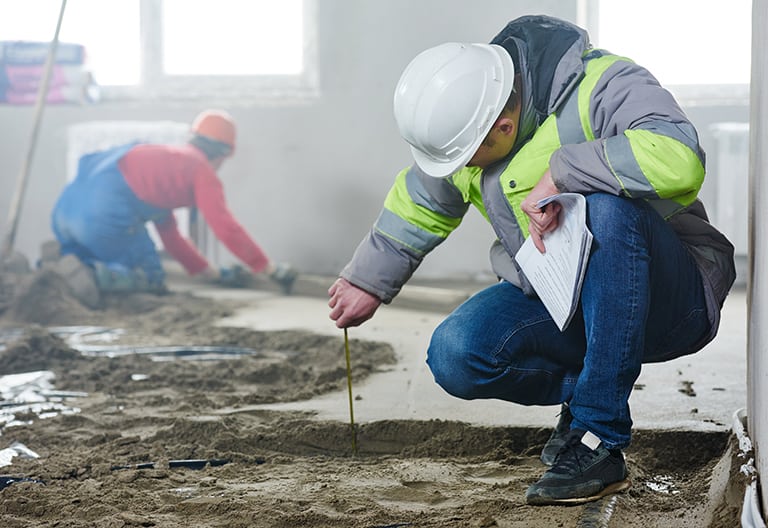
How builders can minimise the risks they face
Posted on 9th November 2022 by Phil Ainley
Few industries face a similar variety and volume of risks as the building and construction sector.
If you operate as a self-employed builder, you will come across a range of risks that you need to be aware of, that differ with every new job.
We look at some of the most common risks and how you can manage them to minimise your exposure to potential accidents and insurance claims.
What risks do builders need to be aware of?
Risk management is important for the success of a construction contract. There are many building risks for self-employed builders to be aware of, some of which include:
- Unpredictability of construction projects
Each building contract is unique in its own way. From the groundwork and foundations to the type of building materials specified, as a result each building project can be unpredictable.
Even small building projects, such as a house extension, can require the involvement of a number of different trades professionals, such as a: bricklayer, electrician, plumber, plasterer, or painter and decorator, each of which must be scheduled and carefully managed by the main building contractor so the project will meet agreed deadlines.
There are also potential issues with supply of building materials and construction equipment, the UK weather, and any manual labour requirements. Not to mention the unpredictability of clients, who can be prone to making additional requests halfway through a project.
- Construction site health and safety risks
Accidents will happen, no matter how careful you are, and building sites are hazardous environments and home to many health and safety risks, including:
- Manual handling, including lifting potentially heavy objects.
- Working at height, on scaffolding and on rooftops.
- Moving objects and machinery, such as mini diggers.
- Working with plant machinery and power tools, including cement mixers and generators.
- Walking across uneven ground.
- Potential for trenches to collapse, especially after heavy rainfall.
- Excessive noise.
- Hand and arm vibrations from using power tools, compactors and drills.
- Potential exposure to caustic materials, when working on older buildings.
- Potentially working in close proximity with electricity, gas and water.
- Dust, airborne fibres, and other irritants.
Some minor injuries can be dealt with in situ, but more serious work-related injuries and sometimes illnesses, can require hospital treatment. If an accident does occur, no matter how minor, it is important to log the details in an accident book.
Preventative measures will help minimise the risk of accidents. A construction risk assessment can help to ensure your business, your staff, subcontractors, and your client are protected.

- Building design risks
- If you provide building designs or plans for your clients and there are errors and/or omissions in your designs that cause a delay and/or an increase in project costs, then you could be subject to a negligence claim for the cost of correcting the designs and to cover any extra building costs incurred.
- You are provided with designs by your client’s architect, but you misinterpret the plans or use materials that don’t meet the agreed specifications, both of which breach the conditions of the contract and cause a delay and an increase in costs in order to rectify the work.
- The agreed timescale of the building work overruns, which can occur due to multiple changes by your client, illness of a key person in your design team, or the need to change the designs to keep costs down to meet the client’s budget.
No matter how careful and organised you are, mistakes can still occur. When it comes to design work, it is important to ensure you’re covered with professional indemnity insurance. This type of business insurance will cover you if a claim of negligent work is made against you, or if an error in your work causes your client a financial loss, such as extra building costs.
- Planning applications, rights of way and public objections can delay building projects
Some building projects can struggle to get past the initial planning phase.
a) Planning applications can be rejected by the council.
b) There can be contradictions in construction documents.
c) Right of way access can cause plans to be redrawn and, in some cases, withdrawn altogether.
d) Temporary construction permits can expire.
These are just a few of the potential risks which can cause building projects to stall. It’s important to plan ahead and ensure all assessments are thorough prior to a project breaking ground to keep to agreed costs and deadlines.
- Construction risks to be aware of, including the 5M’s
Risks to construction projects can include:
a) Changes in technology.
b) Property costs overrunning.
c) Unplanned work that needs to be accommodated. For example, this could be when digging trenches for foundations and discovering water pipes that are damaged and in need of repair or replacement.
To minimise these risks, close monitoring of costs of equipment, materials and labour is required. It’s important to bear in mind that there is not one single factor that can control the cost of a project, there are many, which can be categorised as the 5Ms.
1. Men;
2. Materials;
3. Machinery;
4. Methods;
5. Miscellaneous. (1)
- Organisational risks
The constant rise in inflation is forcing the cost of goods, materials and fuel to rise.
There can be delays to your building projects caused by your supply chain, such as a shortage of delivery drivers at your suppliers, or strikes at ports resulting in imported materials not arriving at trades suppliers on time.
Internally, you can also encounter issues with inexperienced staff and employee churn. If you use the services of subcontractors – such as electricians, plumbers or plasterers – then you can be delayed by their work schedules if their current projects for other clients run over.
These factors require a high level of management skills and forward planning.
- Project management risks
Managing a building project takes organisational skills, yet a building site is a typically untidy, messy and hazardous environment, which is anything but helpful when it comes to being organised.
Issues with the management of construction projects can include:
a) Mislaid paperwork due to untidy filing, or over-reliance on a mobile device.
b) Failing to comply with contractual obligations. Human error can result in certain aspects of a contract being overlooked. Without a clear checklist and muster points for each aspect of a project, it can be easy to miss something, then find you have to return to do additional work to rectify the error.
c) Contractor delays, such as subbies being delayed on other jobs, which pushes your job schedule back.
d) Conflicts between your employees and your subcontractors.
Clear communication and intelligent management of which subcontractors are onsite, and when, can be key to a harmonious and efficient building site.
- Environmental risk factors
Modern building projects typically have many environmental factors to consider.
An environmental risk assessment can identify aspects of the building work that could have a negative impact on the environment. From the resulting report, the main contractor is then tasked with devising ways to eliminate the identified environmental impacts.
Therefore, it’s vital that the environmental risk assessment is thorough and complete so correctly informed decisions can be made, as an incomplete environmental risk analysis could cause costly problems for a building project further down the line.
- External risks to building projects
The external risk factors are those that you simply cannot foresee or control.
Public objections can be a big headache for building contractors, especially where greenbelt land is concerned. Planning applications which might obstruct views that residents do not want tarnishing can be rejected, resulting in compromises and delays.
Rising inflation causes all costs to increase, with fuel and material costs rising monthly, this can cause profits to be significantly reduced from what was originally calculated when the building project was quoted for.
Close monitoring of economic trends, as well as planning ahead, can minimise the impact of external factors on your building project and help to maintain your top-line.
Builders’ public liability
As the main contractor for a construction project, you have the greatest level of liability and the highest risk of potential reputational damage.
Therefore, it is vital to cover all bases in terms of preventing risks to your building projects, and to ensuring your business is protected in the event of a claim if something goes wrong.
Ensure you’re covered with builders’ public liability insurance
The best way to protect your business in case something goes wrong, is to ensure you’re covered by builders’ public liability insurance.
Our trades insurance policies provide protection for your business, for your customers, and for members of the public.
- Public liability insurance (PL)– This public liability policy will cover your business if a claim is made against you for damage to a customers’ property whilst working on a building project. It will also cover you if you are alleged to have caused an accident to your client or another member of the public.
- Employers’ liability insurance (EL)– This policy is a compulsory insurance requirement under the Employers’ Liability Act (1969) and it is a criminal offence not to carry cover if you employ staff. The legal minimum level of cover you must carry is £5million.
The policy will enable you to meet the cost of compensation for an employees’ injuries or disease that they have sustained whilst working for you. Cover can include medical and legal costs, and loss of income, as well as other damages.
You can be fined £2,500 for every day that you are not adequately covered. You can also be fined £1,000 if you do not display your employers’ liability insurance certificate, or if you refuse to make it available to inspectors when they ask for it. (2)
- Tools and trade materials insurance– If you’re a manual tradesman it makes sense to ensure your tools are insured. Including tools cover in your trades insurance policy could save you a lot of money, and help you get back ‘on the tools’ quickly. The policy can also provide cover for lost or damaged tools.
Click the ‘Start your quote’ button to get a quick online quote for your builders’ insurance today.
Or chick here to start your quick online quote
Sources:
- https://www.schedulereader.com/blog/how-to-control-cost-overruns-in-construction-projects/
- https://www.gov.uk/employers-liability-insurance
www.planradar.com/gb/builders-risk/
https://www.highspeedtraining.co.uk/hub/common-construction-hazards
https://www.irejournals.com/formatedpaper/1700058.pdf



